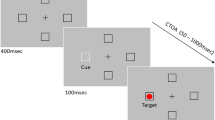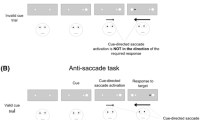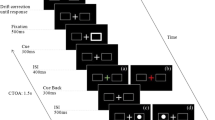Abstract
Experiments on visual attention have employed both physical cues and verbal instructions to enable subjects to allocate attention at a location that becomes relevant within a perceptual or motor task some time later (cue lead time, CLT). In this study we have used valid visual peripheral cues (CLT between 100 and 700 ms) to indicate the direction and location of the next saccade. A cue is considered valid or invalid if its meaning with respect to the next saccade is correct or incorrect. A cue is called an anti- or pro-cue if the side of its presentation is opposite to or the same as the direction of the saccade required on a given trial. Correspondingly, a saccade is called an anti- or pro-saccade if it is directed to the side opposite to or the same as the stimulus presentation. A condition in which the cue and the stimulus are presented on opposite sides provides a simple way of dissociating voluntary attention allocation from automatic orienting. This paper considers the anti-cue pro-saccade task: the subjects were instructed to use the cue to direct attention to the opposite side, i.e. the location, where on valid trials the saccade target would occur. In the companion paper we have used the same physical condition, but we have reversed the instructions as to saccade direction and we have reversed the meaning of the cue, i.e. we designed a pro-cue anti-saccade task. In this first paper, the saccadic reaction times (SRTs) of pro-saccades of five adult subjects were measured in the gap paradigm (fixation point offset precedes target onset by 200 ms). With a CLT of 100 ms, valid anti-cues reduced the number of express saccades (i.e. saccades with SRTs in the range 80–120 ms) significantly compared with the control values (no cues). Valid anti-cues with increasingly long CLTs (100–700 ms) resulted in an increasing incidence of anticipatory saccades and saccades with longer SRTs (more than 120 ms), while the frequency of express saccades remained below the control value. When cue and saccade target were dissociated in location or in both location and direction, the effects of the cueing revealed a much lower spatial selectivity as compared to the effects that have been described for voluntary attention allocation by means of central cues. The results suggest that voluntary allocation of attention and cue-induced automatic orienting not only have different time courses but also have opposite effects on the generation of express saccades, and different spatial selectivities. A possible neuronal basis of these results is discussed considering related findings from electrophysiological studies in monkeys.
Similar content being viewed by others
Author information
Authors and Affiliations
Additional information
Received: 27 March 1997 / Accepted: 17 December 1997
Rights and permissions
About this article
Cite this article
Fischer, B., Weber, H. Effects of pre-cues on voluntary and reflexive saccade generation I. Anti-cues for pro-saccades. Exp Brain Res 120, 403–416 (1998). https://doi.org/10.1007/s002210050414
Issue Date:
DOI: https://doi.org/10.1007/s002210050414




